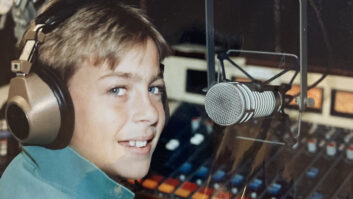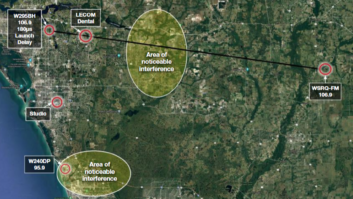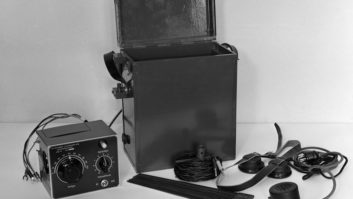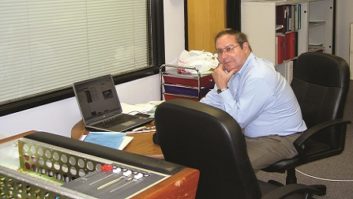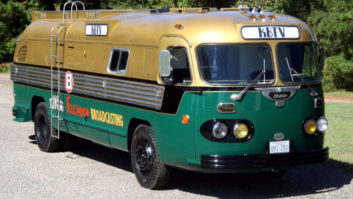One thing I have learned over the years is what kind of vehicle best fits my business for getting the radio broadcast engineering job done. It is a Chevy/GMC Savana van, similar to what a plumber or electrician might drive. Ford has a competing model.
I feel a van is vastly superior to a pickup truck or car because of its ability to carry huge amounts of gear inside and out of the weather. There is room even for objects 10 feet long.

The van I drive has a sliding side door on the passenger side, which is better than swinging doors in the garage at my office. For protection in an accident, the van has a metal wall between the passenger and cargo compartments.
One downside is limited visibility at the rear when backing up. To help solve that problem, I use a backup camera, which cost about $75.
This van comes with all-wheel drive, similar to, if not quite as good as, four-wheel drive. For me, in mostly flatland Minnesota, it is excellent; I haven’t been stuck yet.
My van’s gross vehicle weight rating fully loaded at 7,300 pounds results in only 17.1 miles per gallon, when measured over 5,000 miles of driving, at an average of 41.7 miles per hour, though this is a small price to pay when getting the job done. Also, it is a two-passenger vehicle so it isn’t a family car.
It won’t win any beauty contests either.
Tricked out
I remember an auto salesman telling me that a new car is a “chick magnet.” He said young women will do almost anything to ride in a new vehicle. Well, when buying this most recent van, it didn’t happen that way. I think the car salesman lied to me! But maybe it is because the van is far less than a sports car. Regardless, I am sold on this kind of transportation for this kind of work.
There was a fair bit of radiated engine electrical noise in the factory AM radio in this van. GMC apparently has turned a blind ear to this problem. It probably has everything to do with the Vortec engine. I put bonding straps to the body on the exhaust system, on two computers in the engine compartment and on the engine hood. This tamed the problem down so it is acceptable.
Inside the van are rows of shelves with cardboard boxes measuring 13 x 7 x 3.5 inches. The boxes hold parts and are labeled accordingly.
The parts include F connectors, D connectors, N connectors, RJ-45 connectors, crimp terminals, tie wraps, heat shrink tubing, AC wall power supplies, DC wall power supplies, AM coil clips with strap, ceramic insulators, high-voltage rectifiers, semi-conductors, three boxes of telco parts, two boxes of relays, computer cables, EAS system parts, Sine Systems parts … and the list goes on.
One box is an emergency overnight kit with shaver and toothbrush.
Tools include binoculars for looking at tower problems, spectrum analyzer, Chris Scott AM loop antenna, AM field intensity meter, EIA cable adapters, return loss bridges, AM operating impedance bridge, AM receiver/generator, satellite alignment tools, oscilloscope, audio generator with distortion analyzer, frequency counter, transistor tester, Sencore Z-Meter, FRS two-way radios, camera, huge wrenches, spare hand tools in case there is a problem with tools in my tool and much more.
The tool kit I carry looks like one that a telephone repairman might have used years ago. It has all of the usual hand tools arranged in pockets for easy availability. I hope to tell you about that in an upcoming article.
Ready for the call
The van floor has test equipment in travel cases, cable, boots for walking in AM swamps, a shovel, an electric heater (remember, I work in Minnesota) and a set of six drawers from American Van that contain more parts such as cable connectors. On top of those drawers is a space to put equipment that is coming from or going back to a client station.

It all makes perfect sense for someone who spends a lifetime repairing radio stations.
Power for extra devices in the van is supplied by an MFJ-1124 12 volt distribution panel. Connected to it are some ham radios, a spectrum analyzer outlet and lighting for the interior of the rear of the van. The extra light is a custom-built project with four lamps, which are turned on with one of two pushbuttons and turned off automatically by a two-minute timer. It works great at night when I’m rummaging for parts. Knowledge on how to repair a radio station is required; but so are tools and parts to get the job done.
It was in the U.S. Army that I learned to keep the van gas tank above half most of the time; the phone can ring at any moment with a request to go out to fix a dead transmitter, and I like to be prepared.
The author wrote about backup power generators in October. For more good ideas, visit radioworld.com and click on the Tech Tips tab under News& Technology.
Mark Persons, W0MH, is a Certified Professional Broadcast Engineer and has more than 30 years experience. His website is www.mwpersons.com.





